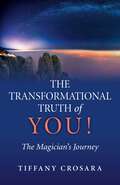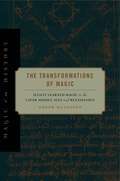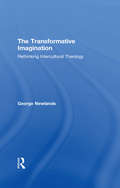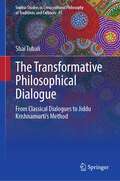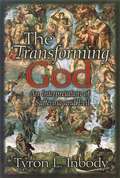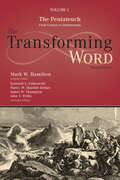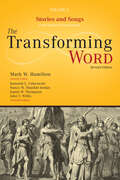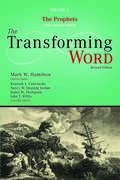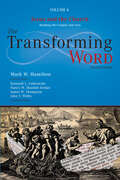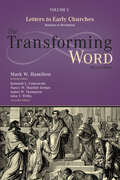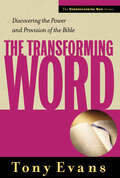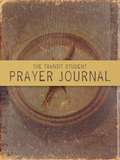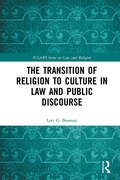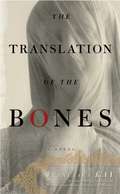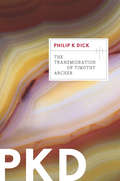- Table View
- List View
The Transformational Truth of YOU!: The Magician's Journey
by Tiffany CrosaraThe second book in the award-winning Transformational Truth series by Tiffany Crosara. The Transformational Truth of You! is a prominent message about how to work with karma to transform it into blessings. A powerful and relevant message for the current times; times of searching for our purpose in order to do ourselves and the world justice. Through archetypal storytelling and true-life stories, the author demonstrates the power of love and loss, trial and tribulation, and the incredible transformative magic contained within them. The book contains channelled information on current personal and worldly shifts and how to develop grace, humility and non-judgment: three key ingredients that help grow the ability to open up and listen to the messages of wisdom contained in the universe, and develop trust in the grand master plan. Find out why the Law of Attraction may not be working for you. Discover the key to your destiny held within your own personal karma and how to transform it into a magical blessing by delving into you and your 'Youinverse!'
The Transformations of Magic: Illicit Learned Magic in the Later Middle Ages and Renaissance (Magic in History)
by Frank KlaassenIn this original, provocative, well-reasoned, and thoroughly documented book, Frank Klaassen proposes that two principal genres of illicit learned magic occur in late medieval manuscripts: image magic, which could be interpreted and justified in scholastic terms, and ritual magic (in its extreme form, overt necromancy), which could not. Image magic tended to be recopied faithfully; ritual magic tended to be adapted and reworked. These two forms of magic did not usually become intermingled in the manuscripts, but were presented separately. While image magic was often copied in the fourteenth and fifteenth centuries, The Transformations of Magic demonstrates that interest in it as an independent genre declined precipitously around 1500. Instead, what persisted was the other, more problematic form of magic: ritual magic. Klaassen shows that texts of medieval ritual magic were cherished in the sixteenth century, and writers of new magical treatises, such as Agrippa von Nettesheim and John Dee, were far more deeply indebted to medieval tradition—and specifically to the medieval tradition of ritual magic—than previous scholars have thought them to be.
The Transformations of Magic: Illicit Learned Magic in the Later Middle Ages and Renaissance (Magic in History)
by Frank KlaassenIn this original, provocative, well-reasoned, and thoroughly documented book, Frank Klaassen proposes that two principal genres of illicit learned magic occur in late medieval manuscripts: image magic, which could be interpreted and justified in scholastic terms, and ritual magic (in its extreme form, overt necromancy), which could not. Image magic tended to be recopied faithfully; ritual magic tended to be adapted and reworked. These two forms of magic did not usually become intermingled in the manuscripts, but were presented separately. While image magic was often copied in the fourteenth and fifteenth centuries, The Transformations of Magic demonstrates that interest in it as an independent genre declined precipitously around 1500. Instead, what persisted was the other, more problematic form of magic: ritual magic. Klaassen shows that texts of medieval ritual magic were cherished in the sixteenth century, and writers of new magical treatises, such as Agrippa von Nettesheim and John Dee, were far more deeply indebted to medieval tradition—and specifically to the medieval tradition of ritual magic—than previous scholars have thought them to be.
The Transformative Imagination: Rethinking Intercultural Theology
by George NewlandsAt the beginning of the twenty-first century there is an increasing tendency to retrenchment within the Christian churches and among other world religions. Religious fundamentalisms are on the increase. In Europe, at least, there is an accelerated decline in church membership. In theology there is a corresponding move away from addressing basic theological issues in the contemporary world, towards increasingly technical interpretation of historical tradition. This book draws on the strengths in classical liberal traditions in theology, augmented by other perspectives, to present a creative proposal for the future of theology and society. George Newlands explores the nature, scope and limits of an intercultural Christian theology, setting out a working model for a new open theology which relates theology and culture. Contributing to the cumulative effort to re-imagine faith in the contemporary world, a focus on the Christian understanding of God lies at the heart of this book. Exploring the interface between theology and particular cultural activities, The Transformative Imagination engages with politics, literature, philosophy and other humanities, and the natural sciences. The relationship between theology and the social and geographical sub-cultures which characterize human life, is explored through diverse examples which make connections and initiate dialogue. Connecting Christian theology and human rights, religion is seen to link constructively with some of the most intractable problems in contemporary global conflicts of interest. Theology is re-situated as a team player, a catalyst to facilitate dialogue in contrast to triumphalist theologies of the past.
The Transformative Philosophical Dialogue: From Classical Dialogues to Jiddu Krishnamurti’s Method (Sophia Studies in Cross-cultural Philosophy of Traditions and Cultures #41)
by Shai TubaliThis book explores dialogue as a transformative form of philosophical practice by unveiling the method behind the unique dialogue developed by mystic and thinker Jiddu Krishnamurti (1895–1986). While Krishnamurti himself generally rejected the cultivation of systems and techniques, Shai Tubali argues that there are easily identifiable patterns through which Krishnamurti strove to realize his dialogical aims. For this reason, he refers to this method, whose existence has evaded Krishnamurti’s followers and scholars alike, as the Krishnamurti dialogue. He suggests that these discursive patterns serve to broaden our understanding of the possibilities of philosophical and religious dialogues and further illuminate established forms of dynamic discourse, such as the Socratic method. Inspired by Pierre Hadot’s revolutionary reading of the classical Greco-Roman texts, the author centers his attention on Plato’s Socratic dialogues and the guru–disciple conversations in the Hindu Upanishads, which fall within the scope of what may be termed ‘the transformative dialogue’: dialogues that have been written with the intention of bringing about a transformation in the mind of the interlocutor and reader and reorienting their way of life. This text appeals to students as well as researchers and suggests that the Krishnamurti dialogue is not only a continuation and development of the transformative dialogue, but that it also amalgamates ingredients of classical Western philosophy and South Asian mysticism. Moreover, this type of dialogue encourages readers to revisit the lost practice of transformative philosophy, in that it reveals new pathways of philosophical and religious inquiry that bear thought-provoking practical implications.
The Transforming Friendship: A Guide to Prayer
by James M. HoustonTo often, prayer seems only to be a dreary exercise that must be endured or a difficult skill that must be mastered. When we misunderstand its purpose and practice, we easily fall out of the habit of praying regularly. As a result, we miss one of the greatest opportunities to deepen our friendship with God. In Prayer: The Transforming Friendship, James Houston explores the transforming power of prayer, illustrating how prayer begins to change our lives and then how the way we live changes how we pray. Through clear and compelling examinations of the Scriptures, Dr. Houston shows the often misunderstood spiritual realities of prayer. And through candid accounts of his own struggles to pray effectively, he will encourage you to engage boldly in the life-changing practice of intimate conversation with God. Dr. James M. Houston, a prolific author, editor, and Christian scholar, is the founding principal, former chancellor and emeritus professor of spiritual theology at Regent College in Vancouver, British Columbia. A native of Scotland whose parents were missionaries to Spain, he is recognized around the world as a leader in educating laypeople for effective ministry and in helping to restore spirituality to evangelicalism. His other book includes The Mentored Life, The Heart's Desire, and Joyful Exiles.
The Transforming God: An Interpretation of Suffering and Evil
by Tyron L. InbodyTheologian Tyron Inbody suggests a new understanding of God in this highly accessible introduction to Christian perspectives of suffering and evil. Interpreting suffering and evil as religious problems, Inbody analyzes and assesses the notion of an all-loving and omnipotent deity found in classical theism. He concludes with a radical reinterpretation of the Christian deity as a vulnerable, transforming God, one recognized by both process and Trinitarian theology.
The Transforming Path: A Christ-Centered Approach to Spiritual Formation
by Terry WardleThis simply-written book lays out a series of pathways that Christians will inevitably face as they move through life with Christ.
The Transforming Word Series, Volume 1: The Pentateuch: From Genesis to Deuteronomy
by Mark HamiltonGod reveals his true nature in the first five books of the Bible.While the broader story of the Bible is known to many Christians, careful readers of the Pentateuch still have many questions. The origin story of the Jewish nation is one of hardship and loss. The Transforming Word will encourage you to examine the Scriptures and discover the God who sustains everything.
The Transforming Word Series, Volume 2: Stories and Songs: From Joshua to Song of Songs
by Mark HamiltonThe nation of Israel tells its story of the rise of kings not once but twice (Joshua–2 Kings, 1–2 Chronicles); and during this period, they wrote Psalms and gathered together their wise sayings. Then, plunged into the darkness of exile, they had to discover again who God was and what kind of life he called them to live. In the same way, Christians read these texts today for what they share about a promised Messiah and how they explain what life with God looks like in all its complexity.
The Transforming Word Series, Volume 3: The Prophets: From Isaiah to Malachi (The Transforming Word #3)
by Mark HamiltonExplore God's vision for a better worldSometimes near the king and the temple courts and at other times on the fringes of society, God's people have always had their social critics. The prophets sought to call everyone back to God's original design. Their call for justice and mercy and their warnings of impending judgment were later echoed by Jesus. One can't know him without hearing what the prophets were saying to the people.Based on the best of recent scholarship, this volume in the Transforming Word series takes the relevance of the prophets seriously and encourages readers with a deeper understanding of their message and calling.
The Transforming Word Series, Volume 4: Jesus and the Church: Reading the Gospels and Acts (The Transforming Word #4)
by Mark HamiltonThe life and work of Jesus Christ must not be overlooked.Born under Roman occupation, Jesus lived his entire life without writing anything down. His earliest followers, the Christians that were shaped by his life and teachings, carefully recorded his words as good news. They also experienced his resurrection and believed that he had entrusted them with a mission to transform the world.
The Transforming Word Series, Volume 5: Letters to Early Churches: From Romans to Revelation (The Transforming Word #4)
by Mark HamiltonThe life and work of Jesus Christ must not be overlooked.Born under Roman occupation, Jesus lived his entire life without writing anything down. His earliest followers, the Christians that were shaped by his life and teachings, carefully recorded his words as good news. They also experienced his resurrection and believed that he had entrusted them with a mission to transform the world.
The Transforming Word: Discovering the Power and Provision of the Bible
by Tony EvansNew in paperback from the Understanding God series. Tony Evans encourages people who have read only portions of the Word to discover its transforming power. He explains the uniqueness of the Bible, how it came to be written, and the blessings and promises it contains. In his down-to-earth style, Evans encourages readers to open their Bibles and their hearts to God's message.
The Transforming Word: Discovering the Power and Provision of the Bible
by Tony EvansNew in paperback from the Understanding God series. Tony Evans encourages people who have read only portions of the Word to discover its transforming power. He explains the uniqueness of the Bible, how it came to be written, and the blessings and promises it contains. In his down-to-earth style, Evans encourages readers to open their Bibles and their hearts to God's message.
The Transit Student Prayer Journal
by Thomas NelsonThis journal will give teens a place to record their prayers, their prayer partners on different topics, and their answers from God. It will become a keepsake treasure to them as they walk in their relationship with their Heavenly Father. The journal will feature introductory material on prayer, journaling, inspirational art, Scripture verses, quotes and more throughout.An Xt4J book.
The Transit Student Prayer Journal
by W Publishing GroupThis journal will give teens a place to record their prayers, their prayer partners on different topics, and their answers from God. It will become a keepsake treasure to them as they walk in their relationship with their Heavenly Father. The journal will feature introductory material on prayer, journaling, inspirational art, Scripture verses, quotes and more throughout.An Xt4J book.
The Transition of Religion to Culture in Law and Public Discourse (ICLARS Series on Law and Religion)
by Lori G. BeamanThis book explores the recent trend toward the transformation of religious symbols and practices into culture in Western democracies. Analyses of three legal cases involving religion in the public sphere are used to illuminate this trend: a municipal council chamber; a town hall; and town board meetings. Each case involves a different national context—Canada, France and the United States—and each illustrates something interesting about the shape-shifting nature of religion, specifically its flexibility and dexterity in the face of the secular, the religious and the plural. Despite the differences in national contexts, in each instance religion is transformed into culture or heritage by the courts to justify or excuse its presence and to distance the state from the possibility that it is violating legal norms of distance from religion. The cultural practice or symbol is represented as a shared national value or activity. Transforming the ‘Other’ into ‘Us’ through reconstitution is also possible. Finally, anxiety about the ‘Other’ becomes part of the story of rendering religion as culture, resulting in the impugning of anyone who dares to question the putative shared culture. The book will be essential reading for students, academics and policy-makers working in the areas of sociology of religion, religious studies, socio-legal studies, law and public policy, constitutional law, religion and politics, and cultural studies.
The Translation of the Bones
by Francesca KayMary-Margaret O'Reilly is seemingly a harmless enough young woman, ready and willing to help out Father Diamond in the Sacred Heart church in Battersea. She may not be very bright, and she is sadly overweight, but she can certainly clean. She is also very good with children, and helps out an Asian woman on her estate whose little boy Shamso is adorable. It is the statue of Jesus on the cross Mary-Margaret is especially drawn to, and one day she decides to give Him a thorough and loving cleansing. But then something strange happens, and moments later she lies unconscious, a great gash in her head, blood on the floor. Word gets out that this strange happening is the opening of the statue's eyes and the flowing of blood from its head. Soon a full-scale religious mania descends on the quiet church, and everyone, from Father Diamond to his small but loyal band of parishioners, is affected by it. When she has recovered, Mary-Margaret returns to the church, and to her duties caring for her housebound and even fatter mother Fidelma. Among the parishioners, Stella Morrison meanwhile impatiently awaits the return of her son Felix from boarding school, and Alice Armitage the return of her much older son from Afghanistan. Mary-Margaret goes back obsessively to the statue of Jesus. He has told her things, things she must act on, and urgently. But He has become remote and uncommunicative once again, and she is in despair. The act she decides on is a shocking one, and it will bring together the lives of the O'Reillys and the Morrisons in a way that will change their lives forever. Francesca Kay's second novel, after the prize-winning AN EQUAL STILLNESS, is at once a profound meditation on the nature of faith and motherhood and a riveting story of passion gone tragically wrong.
The Translation of the Bones: A Novel
by Francesca KayFaith or delusion? Fantasy or fact? From the winner of the 2009 Orange New Writers Award comes a profound meditation on the nature of faith and a riveting story of religious passion gone tragically wrong in London.When word gets out that Mary-Margaret O'Reilly, a somewhat slow-witted but apparently harmless young woman, may have been witness to a miracle, religious mania descends on the Church of the Sacred Heart by the River Thames in Battersea, London. The consequences will be profound, not only for Mary-Margaret herself but for others too--Father Diamond, the parish priest, who is in the midst of his own lonely crisis of faith, and Stella Morrison, adrift in a loveless marriage and aching for her ten-year old son, away at boarding school. Meanwhile another mother, Alice Armitage, counts the days until her soldier son comes home from Afghanistan, and Mary-Margaret's mother, Fidelma, imprisoned in her tower block, stares out over London through her window for hour after hour with nothing but her thoughts for company. This is an exquisite novel about passion and isolation, about the nature of belief, about love and motherhood and a search for truth that goes tragically wrong. Mary-Margaret's desperate attempt to prove that Jesus loves her will change lives in a shocking way. Can anything that is good come out of it; can faith survive sacrifice and pain? Francesca Kay has crafted a novel that is by turns sly and profound. Her crystalline prose unlocks secrets about our capacity to believe and to love. She is a writer who surprises and delights with her language and her stories.
The Transmigration of Timothy Archer: A Maze Of Death /valis / The Divine Invasion / The Transmigration Of Timothy Archer (VALIS Trilogy #3)
by Philip K. DickFrom the acclaimed author of VALIS, the world of an Episcopal bishop is shaken up by death and the discovery of ancient scrolls in Israel. The final book in Philip K. Dick&’s VALIS trilogy, The Transmigration of Timothy Archer brings the author&’s search for the identity and nature of God to a close. The novel follows Bishop Timothy Archer as he travels to Israel, ostensibly to examine ancient scrolls bearing the words of Christ. But, more importantly, this leads him to examine the decisions he made during his life and how they may have contributed to the suicide of his mistress and son. This introspective book is one of Dick&’s most philosophical and literary, delving into the mysteries of religion and of faith itself. As one of Dick&’s final works, it also provides unique insight into the mind of a genius, whose work was still in the process of maturing at the time of his death.&“An eerie and splendid book.&”—Washington Post
The Transnational Mosque: Architecture and Historical Memory in the Contemporary Middle East (Islamic Civilization and Muslim Networks)
by Kishwar RizviKishwar Rizvi, drawing on the multifaceted history of the Middle East, offers a richly illustrated analysis of the role of transnational mosques in the construction of contemporary Muslim identity. As Rizvi explains, transnational mosques are structures built through the support of both government sponsorship, whether in the home country or abroad, and diverse transnational networks. By concentrating on mosques--especially those built at the turn of the twenty-first century--as the epitome of Islamic architecture, Rizvi elucidates their significance as sites for both the validation of religious praxis and the construction of national and religious ideologies.Rizvi delineates the transnational religious, political, economic, and architectural networks supporting mosques in Saudi Arabia, Iran, Turkey, and the United Arab Emirates, as well as in countries within their spheres of influence, such as Pakistan, Syria, and Turkmenistan. She discerns how the buildings feature architectural designs that traverse geographic and temporal distances, gesturing to far-flung places and times for inspiration. Digging deeper, however, Rizvi reveals significant diversity among the mosques--whether in a Wahabi-Sunni kingdom, a Shi&8219;i theocratic government, or a republic balancing secularism and moderate Islam--that repudiates representations of Islam as a monolith. Mosques reveal alliances and contests for influence among multinational corporations, nations, and communities of belief, Rizvi shows, and her work demonstrates how the built environment is a critical resource for understanding culture and politics in the contemporary Middle East and the Islamic world.
The Transnational and the Local in the Politics of Islam
by Delmus Puneri SalimThis book explores the relationship between transnational and local Islam as expressed in public discourse and policy-making, as represented in the local press. It does so against the background of local governments in majority Muslim regions across Indonesia promoting and passing regulations that mandate forms of social or economic behaviour seen to be compatible with Islam. The book situates the political construction of Islamic behaviour in West Sumatra, and in Indonesia more generally, within an historical context in which rulers have in some way engaged with aspects of Islamic practice since the Islamic kingdom era. The book shows that while formal local Islamic regulations of this kind constitute a new development, their introduction has been a product of the same kinds of interactions between international, national and local elements that have characterised the relationship between Islam and politics through the course of Indonesian history. The book challenges the scholarly tendency to over-emphasise local political concerns when explaining this phenomenon, arguing that it is necessary to forefront the complex relationship between local politics and developments in the wider Islamic world. To illustrate the relationship between transnational and local Islam, the book uses detailed case studies of four domains of regulation: Islamic finance, zakat, education and behaviour and dress, in a number of local government areas within the province.
The Transpersonal: Spirituality in Psychotherapy and Counselling
by John RowanIn this new edition of The Transpersonal, John Rowan takes account of the growing interest in spirituality, assessing the many new developments in the field and providing an essential overview of the multitude of guides now available on the subject. By providing a clear and highly readable introduction to the realm of the transpersonal, this book eliminates many of the misunderstandings that plague this area. It relates the transpersonal to everyday life as well as to professional concerns and the various schools of therapy. Divided into three parts, Being, Doing and Knowing, it encourages the reader to explore the levels of consciousness, the techniques involved in transpersonal work and the underlying theory. The unique relationship between the therapist and client is examined in detail, as are the imagined and imaginal world, personal mythology and transcultural work. An entirely new section is included on the ways in which the transpersonal therapist can use the concept of subpersonalities. This fully updated and revised version of John Rowan's original pioneering text provides a highly practical guide which will be useful to anyone working with the growing number of people with spiritual concerns.
The Trapline Thief (Sugar Creek Gang #29)
by Paul HutchensSomeone is stealing muskrats from Circus's traps. When the Sugar Creek Gang follows his hunting dog Old Jay, they discover much more than a raccoon trapped in a tree. This Indian summer adventure includes Halloween pranks, a wild truck ride through an apple orchard, and some genuine fistfights. Everything isn't always what it appears to be on the surface as the Sugar Creek Gang learns that honesty is more than just the best policy . . . it's the way God commands us to live. The Sugar Creek Gang series chronicles the faith-building adventures of a group of fun-loving, courageous Christian boys. These classic stories have been inspiring children to grow in their faith for more than five decades. More than three million copies later, children continue to grow up relating to members of the gang as they struggle with the application of their Christian faith to the adventure of life. Now that these stories have been updated for a new generation, you and your child can join in the Sugar Creek excitement. Paul Hutchens's memories of childhood adventures around the fishing hole, the swimming hole, tie island, and the woods that surround Indiana's Sugar Creek inspired these beloved tales.
